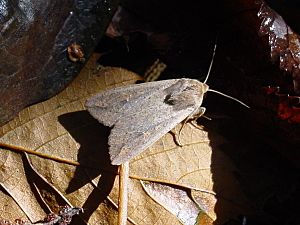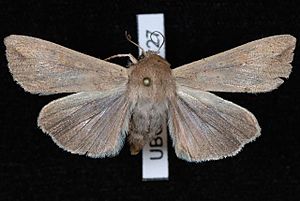True armyworm moth facts for kids
Quick facts for kids True armyworm moth |
|
|---|---|
 |
|
 |
|
| Scientific classification | |
| Synonyms | |
|
The Mythimna unipuncta, also known as the true armyworm moth, is a type of moth that is active at night. It is sometimes called the white-speck moth or common armyworm. This moth belongs to a family called Noctuidae.
The true armyworm moth is known as a pest because its young, called caterpillars, can cause damage to crops. They get the name "armyworm" because the caterpillars move together in huge groups, like an army, from one field to another.
This moth was first described by Adrian Hardy Haworth in 1809. You can find Mythimna unipuncta in the Americas, and in parts of Europe, Africa, and Asia. It originally came from North and South America and has since spread to other places.
True armyworm moths travel long distances. They fly north in the spring and south in the fall. This helps them find the best places to mate in the summer. As they grow from egg to larva, pupa, and then adult, they have to avoid many dangers. These include predatory bugs, birds, wasps, flies, and even diseases caused by bacteria and fungi. Female moths can mate with several males. They release special scents called sex pheromones to attract mates. These scents are affected by temperature and how long the day is. Hearing is also very important for these moths, helping them find mates and escape from bats.
Contents
Where True Armyworms Live
M. unipuncta moths are found all over the world. This includes the Americas, southern Europe, central Africa, and western Asia. In North America, they live in areas east of the Rocky Mountains and in northern Canada.
What True Armyworms Eat
True armyworms eat different things depending on their age.
What Larvae Eat
Young armyworms, called larvae or caterpillars, eat and damage many types of grasses and other farm crops.
- Barley
- Corn
- Oats
- Rice
- Rye
- Sorghum
- Sugarcane
- Wheat
- Alfalfa
- Artichoke
- Beans
- Cabbage
- Carrots
- Celery
- Cucumbers
- Lettuce
- Onions
- Parsley
- Peppers
- Sweet potatoes
What Adults Eat
Adult moths drink nectar from different kinds of flowers. They also eat ripe or decaying fruit.
The Life Cycle of the True Armyworm
The true armyworm goes through several stages to complete its life cycle.
Life Cycle Stages
In one year, there can be two to three groups of armyworms. Each group takes about 30 to 50 days to grow from egg to adult.
Egg Stage
Adult female moths lay their eggs in groups of 2 to 5 rows. They usually place them on dry leaves and grass, often between the leaf and its stem. A female can lay up to 80 eggs in one cluster. This can lead to many caterpillars in one area. One female moth can lay between 500 and 1500 eggs in her lifetime.
The egg stage lasts about 3.5 days in warm weather. In cooler weather, it can take up to 6.5 days. The eggs are usually white or yellowish. They turn gray just before the caterpillars hatch. A sticky material on the eggs helps them stick to plants and stay hidden.
Larva Stage (Caterpillar)
The true armyworm caterpillar stage usually has at least six growth phases, called instars. It can sometimes have up to nine. The caterpillar grows from about 4 millimeters to 35 millimeters long during this stage. This stage lasts about 20 days in warm weather and 30 days in cooler weather.
When the larvae hatch, they eat the leaves where they were laid. If they are disturbed, they can drop to the ground using a silk thread. Older larvae are active at night. They often hide under the soil during the day to stay safe.
Caterpillars are usually grayish-green or grayish-brown. They have special stripes along their bodies.
Pupa Stage
After the larva stage, the caterpillar turns into a pupa. This happens underground inside a silky case that the larva makes. The pupa is usually 13–17 millimeters long and 5–6 millimeters wide. It has two small hooks on its back end.
The pupa stage lasts 7–14 days in warm conditions. In cooler conditions, it can last up to 40 days. The pupa is first yellowish-brown, then changes to a darker mahogany-brown color.
Adult Stage
Adult true armyworms are active at night. The whole process from egg to adult takes 30–50 days. In warm weather, males live about 9 days and females live about 10 days. In cooler weather, males live about 19 days and females live about 17 days.
Adult moths have a wingspan of about 4 centimeters (about 1.5 inches). Their front wings have black dots along the front edge, making them look pointed. There is also a darker area in the middle with several white dots. The back wings are more grayish.
How True Armyworms Migrate
P. unipuncta moths are migratory. This means they travel long distances during different seasons. They fly north in the spring to avoid hot temperatures. They fly south in the winter to escape cold temperatures.
Studies show that female moths raised in hot conditions mated less often. If they did mate, they produced far fewer fertile eggs than females raised in milder temperatures. This suggests that migrating helps them find better conditions for mating. Females flying north in the spring have already developed their ovaries and mated. Females flying south in the fall have not yet developed their reproductive organs. This supports the idea that mating mostly happens in the summer months.
Enemies of the True Armyworm
Many creatures hunt and harm true armyworms.
Predators
Many animals eat armyworm larvae. These include ground beetles, which live in the soil with the armyworms. Other predators are bugs, ants, and spiders. The bobolink, a small blackbird, is sometimes called the "armyworm bird" because it eats so many armyworms. Crows and starlings also eat them.
Parasitoids
Over 60 different types of wasp and fly parasitoids attack the true armyworm. Parasitoid larvae live inside the armyworm and eventually kill it. Examples of wasp parasitoids include Meteorus autographae and Cotesia marginiventris.
Diseases
Bacterial and fungal diseases can harm true armyworms. This is especially true when many armyworms are crowded together. A fungus called Metarhizium anisopliae has been found to infect them. Viral infections can also wipe out entire groups of armyworms. This often happens when there is not enough food or the weather is bad.
Mating and Reproduction
True armyworm moths have interesting ways of finding mates.
Female Calling Behavior
When female moths are ready to mate, they release special scents called sex pheromones. This behavior is called "calling." Females usually start calling about 4–6 days after they become adults. The temperature and how long the day is affect when they start calling. Low temperatures and short days delay calling. Higher temperatures and long days make them start calling sooner. This matches how P. unipuncta behaves each year: they migrate in fall and spring, and prefer to mate in the summer. Females can mate about 5 or 6 times in their lives.
Hormones and Mating
A hormone called the juvenile hormone is important for females to make and release pheromones. This hormone also helps their ovaries develop. If this hormone is removed, females stop making pheromones and their ovaries don't develop properly.
Female Mate Choice
Male moths have special scent organs called hair-pencils. These organs contain chemicals that females can detect with their antennae. Females are more likely to choose males with these scent organs. However, some females will still mate with males that don't have them. Males release less sex pheromone as they mate more often. Females tend to reject males with lower pheromone levels.
Females can reject males in several ways. They might simply walk or fly away. If a male has already grabbed a female, she will arch her body and try to walk or fly away until he lets go.
Male Mating Habits
Males usually wait about three days after becoming adults to start mating. After each mating, a male needs about 6 hours to be ready to mate again. Males usually have at least two partners in their lifetime. Males who mate more often tend to have shorter lives. There is a limit to how many times a male can mate successfully. After about the seventh mating, the eggs in the female may not develop correctly.
In the fall, males do not respond to female pheromones. This shows that males also delay mating before winter and during migration.
Preventing Mating with Other Species
M. unipuncta males can tell the difference between females of their own species and females of other species. They do this by recognizing the specific chemicals in the female's sex pheromone. For example, if a chemical from another moth species' pheromone is added to a M. unipuncta pheromone, the males are less attracted. This ability helps prevent different species from mating with each other.
How True Armyworms Sense the World
Hearing
Hearing is thought to be important for mating. Females often flap their wings faster when males are nearby. Males may make a low trembling sound when they sense female pheromones.
True armyworms also use their hearing to avoid predators. When sounds like those made by bats using echolocation are played, females stop calling and males stop flapping their wings. These moths use their special hearing organs to stop mating behavior when predators are around.
True Armyworms and Humans
A Pest for Farmers
The true armyworm is considered an agricultural pest. During their caterpillar stage, the larvae eat plant leaves. They prefer grassy weeds. But when those weeds are gone, they quickly move to farm crops. Large groups of true armyworms can cause big outbreaks.
For example, in 2012, parts of New York in the United States had a large outbreak of common armyworms. While it stayed in a small area, it destroyed many hay and corn fields.
Farmers can check their fields regularly, especially in early June, if they think armyworms might attack. Special Pheromone traps can help measure how many adult moths are in an area. Signs of damage on leaves show that insecticides or baits might be needed to control an outbreak.
Images for kids
See also
 In Spanish: Mythimna unipuncta para niños
In Spanish: Mythimna unipuncta para niños







